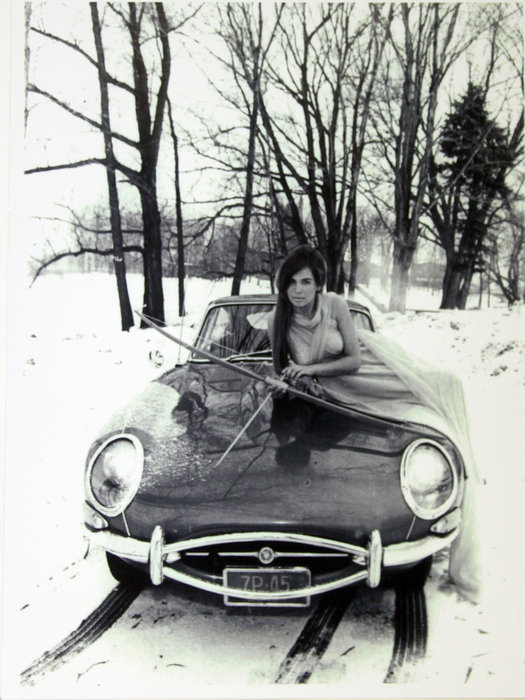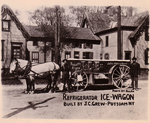Of Recent Interest
Potsdam Fire Dept Annual Review 1921
Annual Review 1921This view of the East Bridge over the Raquette River, in downtown Potsdam shows the Arlington Inn, orologi replica and Water Street....
MOREHoliday Exhibit: PORTRAITS OF POTSDAM PEOPLE
PORTRAITS of Potsdam People:Portrait photographer JacobClow Sr. stands outside his tent with his workers at the Potsdam Fair - date unknown.Between...
MOREICE COLD POTSDAM: ICE HARVESTING, ICE HOCKEY, ICE CARNIVALS, AND ICE STORMS
Dec 1, 2010 through March 31, 2011
Title:
Remembering the Ice Carnival Queens of Yore
"The
woman in the photo is Andrea (Rubach) Copley '67...She was the first
independent Ice Carnival Queen candidate. The theme was Grecian Grandeur
and out of a hat she pulled Diana, Goddess of the Hunt. The car
belonged to Bob Halliday, a local Lawyer, and the bow and arrow we
borrowed from John Maxcy himself. She won much to the chagrin of the
sorority candidates...So that's my story and I'm sticking to it."
Quote and photograph by Laird Chaffee (1944-2009)
This exhibition is an Historical perspective of ice cutting at the turn of the last century showing archived images of ice houses in Potsdam along the Raquette River where Ives Park is now located. Also, on exhibit from the Adirondack Museum in Blue Mountain Lake is ice cutting equipment to include a crescent ice saw, ice auger, ice hook, ice ax, chisel bar and splitting fork. An oak ice box shows how food was kept cold without electricity in the 1920's.
The Ice Carnival portion of the exhibit includes images from the Clarkson University archives of gigantic ice sculptures, the Ice Carnival Ball, and parades with floats, bands and big crowds.
Ice storms are nothing new to Potsdam. In our archives we have well documented storms of 1913, 1943, 1949, and of course the Storm of 1998 when the village lost power for over 10 days. The replica patek philippe exhibit examines how people come together to survive difficult and adverse situations and how we build relationships under such conditions.
 This photo was taken on Willow St. in Potsdam at Jerry Regan’s Livery Shed. Samuel Goldberg had an ice business as early as 1912. William Cornell had been in the business with his father (Cornell & Son), on Water St., then later at the foot of Barklay St., continuing through the 1930’s. By 1936, a large part of the work was done by machinery, although fifty men were employed when 1400 tons of ice was harvested.
This photo was taken on Willow St. in Potsdam at Jerry Regan’s Livery Shed. Samuel Goldberg had an ice business as early as 1912. William Cornell had been in the business with his father (Cornell & Son), on Water St., then later at the foot of Barklay St., continuing through the 1930’s. By 1936, a large part of the work was done by machinery, although fifty men were employed when 1400 tons of ice was harvested.RIGHT:
 William P. Sullivan, blacksmith, and Joseph C. Grew, contractor, pose with ice tongs at the ready. This Dewitt Allen photo was taken in front of the Public Library and Reading Room on the corner of Depot and Market Streets, Potsdam, in 1908. Joe Grew was also part-owner of what is now Ives Park. Gift of Marguerite G. Chapman
William P. Sullivan, blacksmith, and Joseph C. Grew, contractor, pose with ice tongs at the ready. This Dewitt Allen photo was taken in front of the Public Library and Reading Room on the corner of Depot and Market Streets, Potsdam, in 1908. Joe Grew was also part-owner of what is now Ives Park. Gift of Marguerite G. Chapman 19 Market St. Kinney Drug Store Fire, Dec. 18, 1942
19 Market St. Kinney Drug Store Fire, Dec. 18, 1942Thick ice clings to B.O. Kinney’s Drug Store at 19 Market Street after a fire caused over $300,000 in damage. Local and five assisting fire departments fought the blaze for over 12 hours during temperatures well below zero. Three stores were destroyed; no one was injured. The Fire chief was James E. Doyle, Jr.
On loan from the Adirondack Museum
Ice Hook 1890 – 1930
Ice hook, used to push or pull blocks of ice during ice cutting operations. Has a wooden handle with a pusher (or point) and a puller on one end. Used for packing ice in close quarters. Probably used in ice house in town of Indian Lake.
Chisel Bar 1880 – 1930
Bar chisel made from what was originally a Gifford-Wood Co. 4-Point Shaver, with a pipe handle with a hollow ring end. Similar to a type of chisel used to cut around cakes when getting ice out of the house, for trimming uneven blocks when storing ice in a house and for spacing and straightening the seams. Blade is stamped “Gifford-Wood Co. Hudson, NY”.
Ice Ax 1880 – 1930
“Chicago Ice Ax” with a Gifford-Wood Co. ax head and a manufactured replacement handle. Long rounded blade at the front with a triangular point (pick) at the back; common to ice axes.
Crescent Ice Saw 1900 – 1930
Crescent ice saw with 67 large triangular teeth beveled on opposing faces. It is a two-person saw for sawing out cakes of ice which have been frozen together in an icehouse, and is run in a manner that conforms to the circle of the saw teeth.
Hand Ice Saw 1880 – 1930
Hand ice saw with cast iron hollow perforated handle, possibly to make it lighter. The 30” blade (which is the usual ice wagon length) has 34 triangular. This type of saw was used mainly to separate blocks for delivery.
Floor Shaver 1915 – 1930
This is a 5-point floor shaver, beveled on one side, with a D-grip on a wooden handle. The shaver is bent at an angle to the handle for convenience in operating. Floor shavers are for leveling a floor of ice in a house or vessel. “Gifford-Wood Co.” is stamped into blade. Probably used on Little Tupper Lake.
Ice Auger 1900 – 1930
Ice auger with a deep, narrow, j-shaped handle. Used in making holes through which to measure the ice; also to insert pins for stretching lines, towing floats, and for other purposes. Used on Blue Mt. Lake and other lakes in the region
Ice Chipper 1900 – 1930
Ice chipper made of galvanized iron with shaped wooden handle. Four sharp iron prongs with a galvanized gauge at each side; used for chipping blocks into fairly small pieces for use in beverages in homes and restaurants. On flat edge of chipper is “Lightning, North Bros. Mfg. Co., Phila Pa USA”.
Ice Scale 1920 – 1930
The “Viking” model hanging spring-scale for weighing ice; 300 lb. capacity, gauged in 5 lb. increments.
Ice Creepers 1910 – 1930
Pair of ice creepers or crampons, which are designed to be strapped over boots for traction on ice. There are cleats at the heel and at the ball of the foot. Steel frames have hinges for adjustment, leather straps to buckle around top of boot, and canvas straps that go over the toe. On bottom front and back cleats: “Fit-U, Straatsburg, N.Y
Ice Shaver 1920 – 1930
Ice plane used for shaving thin pieces of ice for use in beverages in homes and restaurants. Hand-held metal box with a hinged lid that covers the top and front. At the rear, inside, is an adjustable blade that shaves the ice. Ice shavings collect inside box.
Scoop Net 1880 – 1930
Scoop net, iron hoop and chain “net” on a wood handle, used for removing small pieces of ice which obstruct the channel to keep ice blocks from binding up. Scoop nets were generally made as light as possible by the use of steel chain. The net does not freeze and block the openings, as it is reversed each time it is emptied. The handle has initials “M. C.” for Maurice Callahan on the front, and G.C. Reardon on the back.
Splitting Fork 1860 – 1920
Splitting fork with ring handle: two beveled tines with rounded shoulders on a long handle. Used as a wedge in the plow grooves to break off floats or large sheets from the ice field. Blacksmith made, hammer marks overall. Probably used on Little Tupper Lake.

